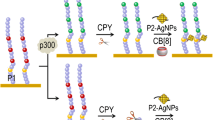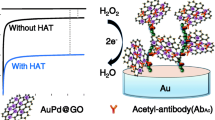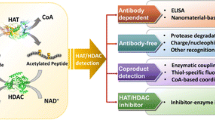Abstract
Acetylation of histones, the major protein component of eukaryotic chromosomes, contributes to the epigenetic regulation of gene expression and is also involved in cancer development. A recent study revealed the correlation between tumour formation and acetylation level of lysine K18 on histone H3. In this study, we developed two colorimetric in vitro assays using gold nanoparticles (AuNPs) for identification of lysine K18 acetylation on histone H3 peptide. In assay I, citrate ion-capped AuNP without further modification was employed. Simply mixing the K18 peptide with AuNP solution leads to distinct particle aggregation, relative to that by non-acetylated or lysine K14 acetylated control peptides. In assay II, an AuNP–peptide–antibody composite was synthesized and used as both the sensing probe and the transducing element. By mixing the sample peptides with the composite solution followed by PBS screening, different aggregation behaviours were observed between the K18 acetylated target peptide and the control sequences. Both assays are capable of identifying the acetylated peptides, and also differentiating the distinctive acetylation positions that differ merely by a distance of three amino acids.




Similar content being viewed by others
References
Agalioti T, Chen G, Thanos D (2002) Deciphering the transcriptional histone acetylation code for a human gene. Cell 111(3):381–392
Arrowsmith CH, Bountra C, Fish PV, Lee K, Schapira M (2012) Epigenetic protein families: a new frontier for drug discovery. Nat Rev Drug Discov 11(5):384–400
Barber MF, Michishita-Kioi E, Xi Y, Tasselli L, Kioi M, Moqtaderi Z, Tennen RI, Paredes S, Young NL, Chen K, Struhl K, Garcia BA, Gozani O, Li W, Chua KF (2012) SIRT7 links H3K18 deacetylation to maintenance of oncogenic transformation. Nature 487:114–118
Bozich JS, Lohse SE, Torelli MD, Murphy CJ, Hamers RJ, Klaper RD (2014) Surface chemistry, charge and ligand type impact the toxicity of gold nanoparticles to daphnia magna. Environ Sci NANO 1:260–270
Britton LM, Gonzales-Cope M, Zee BM, Barcia BA (2011) Breaking the histone code with quantitative mass spectrometry. Expert Rev Proteomics 8(5):631–643
Cerbo VD, Mohn F, Ryan DP, Montellier E, Kacem S, Tropberger P, Kallis E, Holzner M, Hoerner L, Feldmann A, Richter FM, Bannister AJ, Mittler G, Michaelis J, Khochbin S, Feil R, Schuebeler D, Owen-Hughes T, Daujat S, Schneider R (2014) Acetylation of histone H3 at lysine 64 regulates nucleosome dynamics and facilitates transcription. eLife 3:e01632
Chakrabarti R, Klibanov AM (2003) Nanocrystals modified with peptide nucleic acids (PNAs) for selective self-assembly and DNA detection. J Am Chem Soc 125(41):12531–12540
Chandrawati R, Stevens MM (2014) Controlled assembly of peptide-functionalized gold nanoparticles for label-free detection of blood coagulation Factor XIII activity. Chem Commun 50:5431–5434
Collas P (2010) The current state of chromatin immunoprecipitation. Mol Biotechnol 45(1):87–100
Egelhofer TA, Minoda A, Klugman S, Lee K, Kolasinska-Zwierz P, Alekseyenko AA, Cheung MS, Day DS, Gadel S, Gorchakov AA, Gu T, Kharchenko PV, Kuan S, Latorre I, Linder-Basso D, Luu Y, Ngo Q, Perry M, Rechtsteiner A, Riddle NC, Schwartz YB, Shanower GA, Vielle A, Ahringer J, Elgin SCR, Kuroda MI, Pirrotta V, Ren B, Strome S, Park PJ, Karpen GH, Hawkins RD, Lieb JD (2011) An assessment of histone-modification antibody quantity. Nat Struct Mol Biol 18(1):91–93
Guan K-L, Yu W, Lin Y, Xiong Y, Zhao S (2010) Generation of acetyllysine antibodies and affinity enrichment of acetylated peptides. Nat Protoc 5(9):1583–1595
Haun JB, Devaraj NK, Hilderbrand SA, Lee H, Weissleder R (2010) Bioorthogonal chemistry amplifies nanoparticles binding and enhances the sensitivity of cell detection. Nat Nanotechnol 5:660–665
He S, Song B, Li D, Zhu C, Qi W, Wen Y, Wang L, Song S, Fang H, Fan C (2010) A graphene nanoprobe for rapid, sensitive and multicolor fluorescent DNA analysis. Adv Funct Mater 20:453–459
Hyun S, Lee KH, Han A, Yu J (2011) An RNA aptamer that selectively recognizes symmetric demethylation of arginine 8 in the histone H3N-terminal peptide. Nucleic Acid Ther 21(3):157–163
Jenuwein T, Allis CD (2001) Translating the histone code. Science 293:1074–1080
Jones PA, Baylin SB (2007) The epigenomics of cancer. Cell 128(4):683–692
Karczmarski J, Rubel T, Paziewska A, Mikula M, Bujko M, Kober P, Dadlez M, Ostrowski J (2014) Histone H3 lysine 27 acetylation is altered in colon cancer. Clin Proteomics 11:24
Klein JS, Gnanapragasam PNP, Galimidi RP, Foglesong CP, West AP Jr, Bjorkman PJ (2009) Examination of the contributions of size and avidity to the neutralization mechanisms of the anti-HIV antibodies b12 and 4E10. Proc Natl Acad Sci USA 106(18):7385–7390
Kumar S, Aaron J, Sokolov K (2008) Directional conjugation of antibodies to nanoparticles for synthesis of multiplexed optical contrast agents with both delivery and targeting moieties. Nat Protoc 3(2):314–320
Li N, Su X, Lu Y (2015) Nanomaterial-based biosensors using dual transducing elements for solution phase detection. Analyst 140:2916–2943
Lin S, Garcia BA (2012) Examining histone posttranslational modification patterns by high-resolution mass spectrometry. Methods Enzymol 512:3–28
Lou T, Chen Z, Wang Y, Chen L (2011) Blue-to-red colorimetric sensing strategy for Hg2+ and Ag+ via redox-regulated surface chemistry of gold nanoparticles. ACS Appl Mater Interfaces 3(5):1568–1573
Minaker SA, Daze KD, Ma MCF, Hof F (2012) Antibody-free reading of the histone code using a simple chemical sensor array. J Am Chem Soc 134(28):11674–11680
Oishi J, Asami Y, Mori T, Kang JH, Niidome T, Katayama Y (2008) Colorimetric enzymatic activity assay based on noncrosslinking aggregation of gold nanoparticles induced by adsorption of substrate peptides. Biomacromolecules 9(9):2301–2308
Qiao Y, Wang R, Yang X, Tang K, Jing N (2015) Dual roles of histone H3 lysine 9 acetylation in human embryonic stem cell pluripotency and neural differentiation. J Biol Chem 290:2508–2520
Ronzoni S, Faretta M, Ballarini M, Pelicci P, Minucci S (2005) New method to detect histone acetylation levels by flow cytometry. Cytometry Part A 66A(1):52–61
Saha K, Agasti SS, Kim C, Li X, Rotello VM (2012) Gold nanoparticles in chemical and biological sensing. Chem Rev 112(5):2739–2779
Simon MD, Chu F, Racki LR, de la Curz CC, Burlingame AL, Panning B, Narlikar GJ, Shokat KM (2007) The site-specific installation of methyl-lysine analogs into recombinant histones. Cell 128(5):1003–1012
Smet-Nocca C, Wieruszeski JM, Melnyk L, Benecke A (2010) NMR-based detection of acetylation sites in peptides. J Pept Sci 16(8):414–423
Sutarlie L, Aung KMM, Lim MGL, Lukman S, Cheung E, Su X (2014) Studying protein–DNA complexes using gold nanoparticles by exploiting particle aggregation, refractive index change, and fluorescence quenching and enhancement particles. Plasmonics 9(4):753–763
Swartz JD, Gulka CP, Haselton FR, Wright DW (2011) Development of a histidine-targeted spectrophotometric sensor using Ni(II)NTA-functionalized Au and Ag nanoparticles. Langmuir 27(24):15330–15339
Ung T, Liz-Marzán LM, Mulvaney P (2001) Optical properties of thin film of Au@SiO2 particles. J Phys Chem B 105(17):3441–3452
Wang L, Liu X, Hu X, Song S, Fan C (2006) Unmodified gold nanoparticles as a colorimetric probe for potassium DNA aptamers. Chem Commun, 3780–3782
Wang T, Kumru OS, Yi L, Wang YJ, Zhang J, Kim JH, Joshi SB, Middaugh CR, Volkin DB (2013) Effect of ionic strength and pH on the physical and chemical stability of a monoclonal antibody antigen-binding fragment. J Pharm Sci 102(8):2520–2537
Williams BAR, Lin L, Lindsay SM, Chaput JC (2009) Evolution of a histone H4-K16 acetyl-specific DNA aptamer. J Am Chem Soc 131(18):6330–6331
Wilson R (2008) The use of gold nanoparticles in diagnostics and detection. Chem Soc Rev 37:2028–2045
Xia F, Zuo X, Yang R, Xiao Y, Kang D, Vallée-Bélisle A, Gong X, Yuen JD, Hsu BBY, Heeger AJ, Plaxco KW (2010) Colorimetric detection of DNA, small molecules, proteins, and ions using unmodified gold nanoparticles and conjugated polyelectrolytes. Proc Natl Acad Sci USA 107(24):10837–10841
Yoshida W, Kezuka A, Abe K, Wakeda H, Nakabayashi K, Hata K, Ikebukuro K (2013) Detection of histone modification by chromatin immunoprecipitation combined zinc finger luciferase-based bioluminescence resonance energy transfer assay. Anal Chem 85(13):6485–6490
Acknowledgments
Xiaodi Su would like to acknowledge the Agency for Science, Technology and Research (A*STAR), Singapore, for the financial support of JCO 14302FG096 and ETPL/13-R15GAP-0011.
Author information
Authors and Affiliations
Corresponding author
Ethics declarations
Conflict of interest
The authors declare that they have no conflict of interest.
Additional information
Handling Editor: D. Tsikas.
Electronic supplementary material
Below is the link to the electronic supplementary material.
Rights and permissions
About this article
Cite this article
Li, N., Sutarlie, L., Lew, Q.J. et al. Identification of lysine K18 acetylation on histone H3 peptide using gold nanoparticles’ aggregation behaviour. Amino Acids 48, 1023–1031 (2016). https://doi.org/10.1007/s00726-015-2148-1
Received:
Accepted:
Published:
Issue Date:
DOI: https://doi.org/10.1007/s00726-015-2148-1




